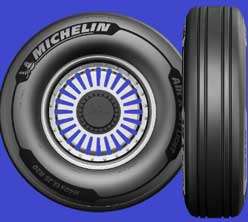 French tyre maker Michelin says its latest new generation aircraft tyre is lighter and longer lasting, offering better performances while guaranteeing the same level of safety.
French tyre maker Michelin says its latest new generation aircraft tyre is lighter and longer lasting, offering better performances while guaranteeing the same level of safety.
With Air X Skylight, Michelin has launched at the 54th Paris Air Show, a new radial tyre technology intended for commercial aviation, a world first. Lighter than previous generations, its weight has been reduced by 10-20%. This major weight saving is accompanied by better performances over the long term (Landing Per Tread (LPT) and also allows for reducing maintenance and transport costs.
It adds that the lifespan of the Air X Skylight will be 15 to 20% longer than its old-generation equivalent.
Weight is an extremely major constraint for aircraft: every kilogram counts and that is why on future aircraft, but also on current aircraft that are retrofitted, the weight reduction actually represents a substantial fuel saving, with less CO2 emissions as well. For example, the weight savings on a Narrow Body aircraft, such as an Airbus A320 or Boeing 737, could represent 75 kg on the main gear. On Wide Body aircraft, such as an Airbus A350 or Boeing 777, the savings could reach up to 250 kg on the main gear.
Consequently, for a fleet of 40 long-haul aircraft, the weight reduction in the tires alone could allow for saving US$900,000 in jet fuel per year and represent a reduction in CO2 emissions of 3,400 tonnes. For a fleet of 100 medium-haul aircraft, the jet fuel savings would be US$600,000, with a reduction of 2,200 tonnes of CO2 over one year.
In order to design Air X Skylight, Michelin says it started with a full and standardised life cycle assessment for a tire, from an environmental angle: this approach demonstrates that the weight is by far the parameter with the most impact (90 to 98%), and that this occurs during the usage phase.
Carrying a tyre at high altitude naturally consumes a lot of energy. On a landing gear, the tyres can weigh from under 50 kg to over 2,000 kg, so reducing the weight is a major challenge.
It adds that Air X Skylight is the result of multiple breakthrough innovations, in terms of architecture, the materials used, and the manufacturing processes. The optimised footprint extends the lifespan by 15-20% compared to the previous generation tyres.
These performances are made possible by the use of ultra-resistant casing materials as well as latest-generation hybrid cables and fabrics. The increasing integration of more sustainable materials is in line with the Michelin Group’s aim to use 100% sustainable materials by 2050.
Furthermore, it adds that innovative manufacturing processes have been developed within the Michelin factory at Bourges, which is dedicated to the Group’s aeronautics activities.
The new aircraft tyre is also 100% compatible with the PresSense connected tyre offer developed in partnership with Safran.
The 1st dimension has been developed to equip the future Dassault Aviation’s Falcon 10X, the test flights for which are planned for the coming months, according to the schedule set out by Dassault Aviation.
The tyre is aimed at the commercial aviation market. The choice of the next tyre dimensions will be defined with regard to the priorities of airlines and aircraft manufacturers.
The development of a new dimension takes between 2 and 3 years and is subject to extremely demanding homologation and certification rules.
The successive dimensions may therefore be fitted to new aircraft, as well as forming the subject of retrofit agreements on existing aircraft, in cooperation with the aircraft manufacturers, the airlines and the aeronautical authorities, rounds up Michelin.
